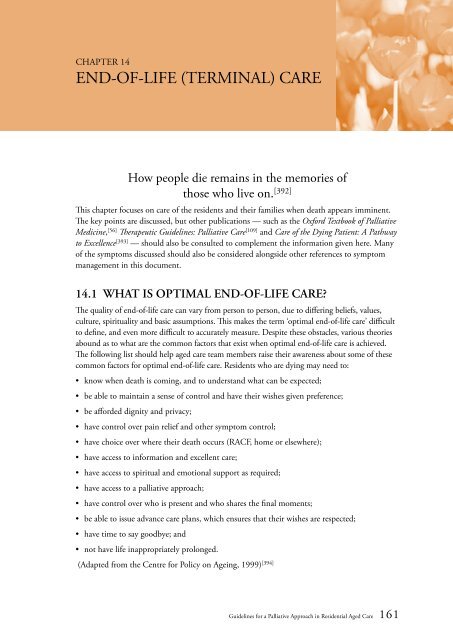Guidelines for a Palliative Approach in Residential Aged Care
Guidelines for a Palliative Approach in Residential Aged Care
Guidelines for a Palliative Approach in Residential Aged Care
Create successful ePaper yourself
Turn your PDF publications into a flip-book with our unique Google optimized e-Paper software.
CHAPTER 14<br />
END-OF-LIFE (TERMINAL) CARE<br />
How people die rema<strong>in</strong>s <strong>in</strong> the memories of<br />
those who live on. [392]<br />
This chapter focuses on care of the residents and their families when death appears imm<strong>in</strong>ent.<br />
The key po<strong>in</strong>ts are discussed, but other publications — such as the Ox<strong>for</strong>d Textbook of <strong>Palliative</strong><br />
Medic<strong>in</strong>e, [56] Therapeutic <strong>Guidel<strong>in</strong>es</strong>: <strong>Palliative</strong> <strong>Care</strong> [109] and <strong>Care</strong> of the Dy<strong>in</strong>g Patient: A Pathway<br />
to Excellence [393] — should also be consulted to complement the <strong>in</strong><strong>for</strong>mation given here. Many<br />
of the symptoms discussed should also be considered alongside other references to symptom<br />
management <strong>in</strong> this document.<br />
14.1 WHAT IS OPTIMAL END-OF-LIFE CARE?<br />
The quality of end-of-life care can vary from person to person, due to differ<strong>in</strong>g beliefs, values,<br />
culture, spirituality and basic assumptions. This makes the term ‘optimal end-of-life care’ difficult<br />
to def<strong>in</strong>e, and even more difficult to accurately measure. Despite these obstacles, various theories<br />
abound as to what are the common factors that exist when optimal end-of-life care is achieved.<br />
The follow<strong>in</strong>g list should help aged care team members raise their awareness about some of these<br />
common factors <strong>for</strong> optimal end-of-life care. Residents who are dy<strong>in</strong>g may need to:<br />
• know when death is com<strong>in</strong>g, and to understand what can be expected;<br />
• be able to ma<strong>in</strong>ta<strong>in</strong> a sense of control and have their wishes given preference;<br />
• be af<strong>for</strong>ded dignity and privacy;<br />
• have control over pa<strong>in</strong> relief and other symptom control;<br />
• have choice over where their death occurs (RACF, home or elsewhere);<br />
• have access to <strong>in</strong><strong>for</strong>mation and excellent care;<br />
• have access to spiritual and emotional support as required;<br />
• have access to a palliative approach;<br />
• have control over who is present and who shares the f<strong>in</strong>al moments;<br />
• be able to issue advance care plans, which ensures that their wishes are respected;<br />
• have time to say goodbye; and<br />
• not have life <strong>in</strong>appropriately prolonged.<br />
(Adapted from the Centre <strong>for</strong> Policy on Age<strong>in</strong>g, 1999) [394]<br />
<strong>Guidel<strong>in</strong>es</strong> <strong>for</strong> a <strong>Palliative</strong> <strong>Approach</strong> <strong>in</strong> <strong>Residential</strong> <strong>Aged</strong> <strong>Care</strong> 161
















